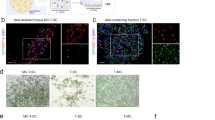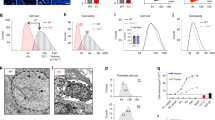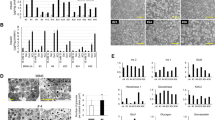Abstract
Our aim is to use cultured cells capable of regulated protein secretion for the production of recombi-nant proteins that require particular types of post-translational modifications. Here we have generated a stable transfected βTC-3 cell line, βTC-IPR9, that secretes high levels of recombinant prolactin. Transfected cells synthesize both the 27 kDa glycosylated and a 23 kDa nonglycosylated prolactin; the 23 kDa nonglycosylated species was secreted preferentially when cells were placed in secretion medium containing isobutylmethylxanthine (IBMX) and high concentrations of glucose, K+, and Ca2+. When the cells were cultured in medium containing low concentrations of glucose, K+, and Ca2+, most of the prolactin and insulin were not secreted; much of the prolactin was proteolytically converted to a 16 kDa form. Within the first 30 minutes after transferring the cells to medium containing secretagogues there was a 20-fold increase in the rate of secretion of prolactin; all of the 16 kDa species was secreted. The recombinant cells could be cycled several times between medium in which prolactin was biosynthesized and medium in which it was secreted. Preferential secretion of proteolytically processed prolactin in a medium without contaminating proteins offers an example of the advantage of this technology for production of other recombinant proteins.
This is a preview of subscription content, access via your institution
Access options
Subscribe to this journal
Receive 12 print issues and online access
$209.00 per year
only $17.42 per issue
Buy this article
- Purchase on Springer Link
- Instant access to full article PDF
Prices may be subject to local taxes which are calculated during checkout
Similar content being viewed by others
References
Gething, M.-J. and Sambrook, J. 1992. Protein folding in the cell. Nature 355: 33–45.
Elbein, A.D. 1991. The role of N-linked oligosaccharides in glycoprotein function. T1BTECH 9: 346–352.
Lodish, H., Kong, N. and Wikstrom, L. 1992. Calcium is required for folding of newly made subunits of the asialoglycoprotein receptor within the endoplasmic reticulum. J. Biol. Chem. 267: 12753–12760.
Hwang, C., Sinskey, A. and Lodish, H. 1992. The oxidized redox potential in the endoplasmic reticulum: Glutathione as the principal redox buffer. Science 257: 1496–1502.
Braakman, I., Helenius, J. and Helenius, A. 1992. Manipulating disulfide bond formation and protein folding in the endoplasmic reticulum. EMBO 11: 1717–1722.
Hutton, J.C. 1990. Subtilisin-like proteinases involved in the activation of proproteins of the eukaryotic secretory pathway. Curr. Opin. Cell. Biol. 2: 1131–1142.
Darby, N.J. and Smyth, D.G. 1990. Endopeptidases and prohormone processing. Bioscience Reports 10: 1–13.
Barr, P.J. 1991. Mammalian subtilisins: The long-sought dibasic processing endoproteases. Cell 66: 1–3.
Davison, H.W., Rhodes, C.J. and Hutton, J.C. 1988. Intraorganellar calcium and pH control proinsulin cleavage in the pancreatic β cell via two distinct site-specific endopeptidases. Nature 333: 93–96.
Sambanis, A., Stephanopoulos, G., Sinskey, A.J. and Lodish, H.F. 1990. Use of regulated secretion in protein production from animal cells: an evaluation with the AfT-20 model cell line. Biotech. Bioeng. 35: 771–780.
Sambanis, A., Stephanopoulos, G. and Lodish, H.F. 1990. Multiple episodes of induced secretion of human growth hormone from recombinant AtT-20 cells. Cytotechnology 4: 111–119.
Grampp, G.E. 1992. Controlled protein secretion in animal cell culture. Ph.D thesis, Massachusetts Institute of Technology, Cambridge, MA.
Smeekens, S.P., Albiges-Rizo, C., Carroll, R., Martin, S., Ohagi, S., Phillips, L.A., Benig, M., Gardner, P., Montag, A.G., Swift, H.H., Thomas, G. and Steiner, D.F. 1992. Proinsulin processing by the subtilisin-reiated proprotein convertases furin, PC2 and PC3. Proc. Natl. Acad. Sci. USA 89: 8822–8826.
Smeekens, S.P. 1993. Processing of protein precursors by a novel family of subtilisin-reiated mammalian endoproteases. Bio/Technology 11: 182–186.
Efrat, S., Linde, L., Kofod, H., Spector, D., Delannoy, M., Grant, S., Hanahan, D. and Baekkeskov, S. 1988. Beta-cell lines derived from transgenic mice expressing a hybrid insulin gene-oncogene. Proc. Natl. Acad. Sci. USA 85: 9037–9041.
D'ambra, R., Surana, M., Efrat, S., Starr, R.G. and Fleischer, N. 1990. Regulation of insulin secretion from β-cell lines derived from transgenic mice insulinomas resembles that of normal β-cells. Endocrinology 126: 2815–2822.
Efrat, S., Leiser, M., Surana, M., Tal, M., Fusco-Demane, D. and Fleischer, N. 1993. Murine insulinoma cell line with normal glucose-regulated insulin secretion. Diabetes 42: 901–907.
Cooke, N.E. 1989. Prolactin: normal synthesis, regulation and actions, p. 384–407. In: Endocrinology. DeGroot, L. J. (Ed.). WB Saunders, Philadelphia.
Smith, C.R. and Norman, M.R. 1990. Prolactin and growth hormone: molecular heterogeneity and measurement in serum. Ann Clin, Biochem 27: 542–550.
Lewis, U.J., Singh, R.N.P., Lewis, L.J., Seavey, B. and Sinha, Y.N. 1984. Glycosylated ovine prolactin. Proc. Natl. Acad. Sci. USA 81: 385–389.
Cole, E.S., Nichols, E.H., Lauziere, K., Edmunds, T. and McPherson, J.M. 1991. Characterization of the microheterogeneity of recombinant primate prolactin: Implications for posttranslational modifications of the hormone in vivo. Endocrinology 129: 2639–2646.
Lewis, U.J., Singh, R.N.P., Sinha, Y.N. and Vanderlaan, W.P. 1985. Glycosylated human prolactin. Endocrinology 116: 359–363.
Mittra, I. 1980. A novel “cleaved prolactin” in the rat pituitary. I. Biosynthesis, characterization and regulatory control. Biochem. Biophys. Res. Commun. 95: 1750–1759.
Mittra, I. 1980. A novel “cleaved prolactin” in the rat pituitary. II. In vivo mammary mitogenic activity of its N-terminal 16K moiety. Biochem Biophys Res Commun 95: 1760–1767.
Pellegrini, I., Gunz, G., Grisoli, F. and Jaquet, P. 1990. Different pathways of secretion for glycosylated and nonglycosylated human prolactin. Endocrinology 126: 1087–1095.
Jain, K., Zucker, P.F., Chan, A.M. and Archer, M.C. 1985. Monolayer culture of pancreatic islets from the Syrian hamster. In Vitro 21: 1–5.
Efrat, S., Surana, M. and Fleischer, N. 1991. Glucose induces insulin transcription in a murine pancreatic β-cell line. J. Biol. Chem. 266: 11141–11143.
Steiner, D.F., Docherty, K. and Carroll, R. 1984. Golgi/granule processing of peptide hormone and neuropeptide precursors: a minireview. J. Cell. Biochem. 24: 121–130.
Steiner, D.F., Michael, J., Houghten, R., Mathieu, M., Gardner, P.R., Ravazzola, M. and Orci, L. 1987. Use of a synthetic peptide antigen to generate antisera reactive with a proteolytic processing site in native human proinsulin: Demonstration of cleavage within clathrin-coated (pro)secretory vesicles. Proc. Natl. Acad. Sci. USA 84: 6184–6188.
Smeekens, S.P. and Steiner, D.F. 1990. Identification of a human insulinoma cDNA encoding a novel mammalian protein structurally related to the yeast dibasic processing protease Kex2 J. Biol. Chem. 265: 2997–3000.
Seidah, N.G., Gaspar, L., Mion, P., Marcinkiewicz, M.M., Mbikay, M. and Chretien, M. 1990. cDNA sequence of two distinct pituitary proteins homologous to Kex 2 and furin gene products: tissue-specific mRNAs encoding candidates for pro-hormone processing proteinases. DNA Cell Biol. 9: 415–424.
Smeekens, S.P., Avruch, A.S., LaMendola, J., Chan, S.J. and Steiner, D.F. 1991. Identification of a cDNA encoding a second putative prohormone convertase related to PC2 in AtT20 cells and islets of Langerhans. Proc. Natl. Acad. Sci. USA 88: 340–344.
Bailyes, E.M., Shennan, K.I.J., Seal, A.J., Smeekens, S.P., Steiner, D.F., Hutton, J.C. and Docherty, K. 1992. A member of the eukaryotic subtilisin family (PC3) has the enzymic properties of the type 1 proinsulin-converting endopeptidase. Biochem. J. 285: 391–394.
Moore, H.-P.H. and Kelly, R.B. 1983. Expressing a human proinsulin cDNA in a mouse ACTH-secreting cell. Intracellular storage, proteolytic processing, and secretion on stimulation. Cell 35: 531–538.
Wong, V.L.Y., Compton, M.M., Witorsch, R.J. 1986. Proteolytic modification of rat prolactin by subcellular fractions of the lactating rat mammary gland. Biochim. Biophys. Acta 881: 167–174.
Compton, M.M. and Witorsch, R.J. 1984. Proteolytic degradation and modification of rat prolactin by subcellular fractions of the rat ventral prostate gland. Endocrinology 115: 476–484.
Nolin, J.M. 1982. Molecular homology between prolactin and ovarian peptides: Evidence for physiologic modification of the parent molecule by the target. Peptides 3: 823–831.
Ferrara, N., Clapp, C. and Weiner, R. 1991. The 16K fragment of prolactin specifically inhibits basal or fibroblast growth factor stimulated growth of capillary endothelial cells. Endocrinology 129: 896–900.
Felgner, P.L., Gadek, T.R., Holm, M., Roman, R., Chan, H.W., Wenz, M., Northrop, J.P., Ringold, G.M. and Danielsen, M. 1987. Lipofectin: A highly efficient, lipid-mediated DNA-transfection procedure. Proc. Natl. Acad. Sci. USA 84: 7413–7417.
Akbar, A.M., Kannan, C.R. and Burke, G. 1975. The clinical utility of a heterologous radioimmunoassay for human prolactin. Clinica Chimica Acta 61: 391–398.
Laemmli, U.K. 1970. Cleavage of structural proteins during the assembly of the head of bacteriophage T4. Nature 227: 680–685.
Hirani, S., Bernasconi, R.J. and Rasmussen, J.R. 1987. Use of N-glycanase to release Asparagine-linked oligosaccharides for structural analysis. Anal. Biochem 162: 485–492.
Plummer, T.H. Jr., Elder, J.H., Alexander, S., Phelan, A.W. and Tarentino, A.L. 1984. Demonstration of peptide: N-glycosidase F activity in endo-β-N-acetylglucosaminidase F preparations. J. Biol. Chem. 259: 10700–10704.
Author information
Authors and Affiliations
Rights and permissions
About this article
Cite this article
Chen, K., Stephanopoulos, G., Sinskey, A. et al. Regulated Secretion of Prolactin by the Mouse Insulinoma Cell Line βTC-3. Nat Biotechnol 13, 1191–1197 (1995). https://doi.org/10.1038/nbt1195-1191
Received:
Accepted:
Issue Date:
DOI: https://doi.org/10.1038/nbt1195-1191



